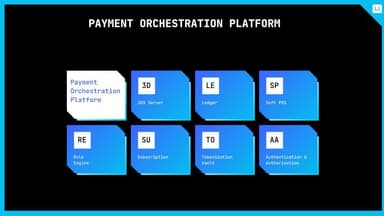Insights


Global Payments Orchestration Platform: Solving Cross-Border Challenges
Global Payments Orchestration Platform: Solving Cross-Border Payment Challenges
Expanding your business globally comes with immense opportunities – and equally significant payment challenges. Different countries have different preferred payment methods, currencies, banking regulations, and risk profiles. A global payments orchestration platform is designed to address these challenges by providing a unified solution that works across borders. In this article, we focus on how orchestration helps merchants optimize international payment acceptance rates, drive down cross-border costs (even approaching zero incremental cost per transaction in some cases), and scale seamlessly across regions.
Cross-Border Payments: The Challenges Enterprises Face
Let’s first outline what makes cross-border payments complicated for merchants and payment professionals:
Diverse Payment Preferences: Globally, customers use a wide array of payment methods. In the US a credit card might dominate, in Germany many prefer SEPA or PayPal, in Asia-Pacific regions like China wallets (Alipay, WeChat Pay) are king, and in Latin America there are local methods like Boleto or OXXO. A merchant wanting to succeed internationally must offer localized payment options to maximize conversion. Integrating each of these methods separately is daunting.
Multi-Currency and FX Costs: Selling in multiple currencies means you either let customers pay in their local currency (and you handle currency conversion), or you bill in your currency (and the customer sees unpredictable conversion rates/fees from their bank). Neither is trivial: accepting and settling in dozens of currencies requires managing forex spreads, possibly maintaining bank accounts in different currencies, and dealing with currency risk. If you rely on a single payment provider, they might charge hefty conversion fees on each transaction, cutting into margins.
Cross-Border Transaction Fees: Card networks often classify transactions as domestic vs. cross-border. A cross-border transaction (where the merchant’s acquirer is in a different country than the card issuer) usually incurs higher interchange fees and lower authorization rates. Without local acquiring presence, merchants can end up paying more and getting less approvals. For example, a Brazilian customer using a local credit card might get declined more often if the transaction is processed by a US-based acquirer, and even if approved, the fee is higher.
Regulatory and Compliance Differences: Every region has its rules – European PSD2 SCA requirements, data localization laws in some countries (requiring payment data to stay in-region), RBI regulations in India (like two-factor auth on cards, restrictions on tokenization), etc. Navigating these as an outsider is difficult. If your payment setup isn’t compliant locally, you could get transactions declined or face legal issues.
Operational Complexity: Handling multiple banking relationships or PSP contracts, settlement in various countries, reconciliation across borders – all adds complexity. Time zone differences and language barriers with providers can make support and issue resolution slower. For example, if you have one gateway for North America and another for Asia, your teams have to manage two systems and processes.
Fraud Variation by Region: Fraud patterns differ; what looks suspicious in one country might be normal in another. Also, merchants expanding globally often see initial fraud spikes as fraudsters test new international vectors. Adapting fraud prevention per region is critical to avoid both fraud losses and unnecessary declines of valid orders.
In short, going global with payments without the right infrastructure is a recipe for lower acceptance, higher costs, and a lot of headaches. This is where a global payments orchestration platform shines.
How a Global Orchestration Platform Solves Cross-Border Issues
A global payment orchestration platform acts as a layer of intelligence and connectivity across all regions, helping you handle each of the above challenges systematically:
1. Unified Access to Local Payment Methods: The platform offers a single integration for the merchant, but under the hood it connects to a vast network of local payment methods worldwide. Want to offer iDEAL in the Netherlands, Giropay in Germany, or PIX in Brazil? A capable orchestration platform likely has these connectors ready. You can toggle them on for the relevant geographies, often just by enabling in the dashboard. This means you can cater to local preferences without lengthy bank negotiations or custom builds. The orchestration platform basically acts as your payments buffet – pick and choose which methods to enable per country/region.
2. Multi-Acquirer, Multi-PSP Routing (Local Acquiring): To solve the cross-border fee and approval issue, the platform allows you to route transactions through local acquirers in different regions. For example, for European transactions, route through a European acquiring bank; for Asian transactions, through an Asia-based processor, etc. Many large orchestrators have either partnerships or integrations with acquiring banks on every major continent. The benefit is two-fold:
Lower fees: Local transactions avoid cross-border interchange uplift. As one analysis put it, using the optimal acquirer for each location can minimize interchange and cross-border fees significantly. If a platform helps an airline implement a local acquirer strategy, they drastically reduce those extra costs on each ticket sale.
Higher acceptance: Local acquirers often have better connections with issuers in their region, meaning they can approve more transactions (issuer banks sometimes trust domestic requests more). Orchestrators expand your network of acquirers so you can send a transaction to “the right acquirer at the right time” – e.g., a Japanese card goes to a Japan-based acquirer for authorization. This optimizes approval odds.
In practice, the orchestration platform will identify the customer’s region from the card BIN or selected payment method and then use a routing rule: “if Latin America card, use Acquirer X (LatAm); if European card, Acquirer Y (EU)”, etc. It’s like having a global payment switchboard that always finds the local lane for you. The result can be significantly higher success rates – some merchants see jumps of 5-10 percentage points in authorization rates in new markets by adding local routing, which translates to huge revenue gains. One industry where this is critical is airlines, where selling tickets globally but processing locally is key; payment orchestration was noted as critical to cross-border sales success by harmonizing buyers and sellers worldwide.
3. Currency Optimization: A global platform often supports multi-currency processing end-to-end. You can charge customers in (and display prices in) their local currency, while you as the merchant can choose to settle in that currency or convert to your base currency. Many orchestration platforms provide competitive FX conversion or allow you to hold balances in different currencies to then use for payouts or conversion at opportune times. They might integrate with fintech services for real-time FX rates to offer customers Dynamic Currency Conversion (DCC) or to optimize when converting funds. This level of control can reduce the hidden costs of currency conversion. Some advanced strategies include routing to acquirers who can settle in the currency you prefer (so no conversion at all by the time you receive money). In an ideal setup, the extra cost of accepting a foreign currency payment can approach zero because you’re always using the most efficient currency route (for instance, processing a Euro payment with a European acquirer and settling in EUR to your EUR account – no conversion fee).
Additionally, orchestration can ensure consistent customer experience with currency. For example, if a Japanese customer wants to be charged in JPY on your US-based website, the platform can present JPY and handle converting and routing that transaction appropriately. Without orchestration, you might only offer a few currencies or rely on a PSP that marks up the conversion by 3% – a direct hit to your margins or an annoyance to customers.
4. Global Fraud Management: A worldwide presence means potentially facing fraud attacks coming from many corners. A global orchestration platform helps by aggregating fraud data globally and also letting you apply rules per region. For instance, you might notice higher fraud from one country – you can tighten rules there (maybe require 3DS or reject high-risk orders), while keeping rules lenient where fraud is low to maximize conversion. The orchestration’s fraud module can often incorporate region-specific checks (like address verification (AVS) may work in the US but not in Asia, 3DS is a must in Europe, etc.). By centralizing this, you ensure compliance with local security mandates and guard against fraud, without fragmenting your tooling. Also, sharing intelligence globally means if a fraudster hits you in one country and then tries another, the system has memory – it can block them outright. On the flip side, returning legitimate customers benefit: the platform recognizes them across regions (say a good customer who bought in UK and now is buying in US site) and maybe fast-tracks their checkout (less friction).
5. Compliance and Localization: Keeping up with local regulations is a behind-the-scenes benefit of orchestration. The platform provider will typically handle updates needed for compliance. For example, when India enacted new data storage rules for payments, a global orchestration platform operating there would ensure that card tokens are stored as per guidelines (perhaps storing Indian card tokens on servers in India, if required) – all transparent to the merchant. Similarly, the platform can adapt to PSD2 requirements in EEA by providing the necessary 3DS integrations and flags in transactions. Essentially, the orchestration layer abstracts away many regulatory differences – you integrate once and the platform’s connectors take care of local quirks.
Language and localized interfaces can be another aspect – some orchestration systems provide interfaces (like payment pages) that automatically translate and format things (dates, addresses) to the local norm, improving user trust and completion rates.
6. Scalability and Performance: When scaling globally, volume and latency are considerations. A good global orchestration platform is built to be highly scalable and distributed. They may have data centers in multiple regions to process transactions nearby to customers (reducing latency – important for ensuring transactions don’t time out, especially when every millisecond counts in an online auth). They are also fault-tolerant: if one data center or processor fails, others pick up the load. This resilience is particularly crucial for a follow-the-sun business – you’re selling 24/7 across time zones, so the platform must have near-100% uptime. Many platform providers advertise strong uptime SLAs (like 99.99% or above) and have built-in redundancy.
From a merchant’s perspective, this means you don’t worry about whether your system can handle Black Friday in multiple countries at once – the orchestration platform is elastically handling it.
Optimizing Payment Acceptance Rates Globally
One of the headline benefits of using a global payments orchestration platform is higher authorization and payment acceptance rates worldwide. Let’s unpack how exactly it does that:
Intelligent Transaction Routing: As discussed, by routing each payment to the acquirer or processor that has the best chance of approving it (based on geographic logic or even historical performance data), the platform avoids unnecessary declines. For instance, it might know that for transactions in Mexico, PSP A has a 85% approval rate while PSP B has 78%; it will favor PSP A for that region. These optimizations can be driven by machine learning over time, continuously improving as more data flows. Over a large volume, even a 2% lift in approval can mean millions in revenue saved.
Automated Retries (Smart Retries): Some declines are soft (temporary issues). A global platform can schedule retries at smarter intervals and times. It might also attempt retries in the cardholder’s local nighttime if the issue was “issuer unavailable” etc., to catch a better moment. By tailoring retry logic per region (taking into account local banking hours or typical issuer batch times), it squeezes more approvals out of initially failed transactions. This is especially useful for global subscription businesses – for example, if a monthly renewal fails for a German customer on the 1st attempt, the platform might try again early morning local time when perhaps the issuer systems are less busy.
Multiple Acquirer Connections in Each Region: In some markets, even local acquirers have varying acceptance for different card types or customer segments. A global orchestrator can connect to multiple acquirers in the same country and do intelligent load balancing or failover among them. For example, a merchant in Asia might use two acquiring banks in Singapore; if one shows an outage or high decline rates, transactions can be shifted to the other in real-time. This ensures continuity.
Reducing False Declines: Fraud checks are a common cause of legitimate transactions being declined (false positives). By calibrating fraud rules finely per region – either via the platform’s rule engine or using regional fraud tools – orchestration can reduce false declines, which directly improves acceptance. For example, U.S. merchants might initially be wary of international cards and decline some, but as they get more global data via orchestration, they can safely approve more of those international orders by recognizing patterns of legitimate international buyers.
Local Payment Method Acceptance: Not all “payments” are card authorizations. Acceptance rate also means giving customers a way to pay that they won’t drop off from. If a customer prefers a certain local e-wallet and you provide it via orchestration, you “accept” a sale you would have lost otherwise. So offering the right mix of payment options per country dramatically improves overall conversion. Studies have shown that giving customers their preferred payment method can increase sales and reduce cart abandonment. A global POP enables this tailored checkout experience everywhere.
Real-world context: Many enterprise merchants have reported substantial uplift after implementing orchestration globally. For instance, a digital goods retailer expanded to 10 new countries in a year – by using an orchestration platform, they immediately achieved local-like performance in each (fast checkout with local methods, high approval rates). Without it, each country rollout would have been slower and likely seen lower initial payment performance.
To put a number from earlier: IXOPAY’s team noted that combining risk-based routing with cascading gave merchants about 15% increase in acceptance. Similarly, Akurateco cited up to 30% conversion rate increase with smart cascading. These figures underscore how impactful optimization is when you aggregate small improvements (2% here, 5% there across countries and methods).
Cost Optimization: Driving Payment Costs “Down to 0”
When the prompt mentions cost optimization “down to 0”, it likely refers to minimizing the extra costs associated with payments – not literally eliminating all costs (you’ll still have interchange or base costs mandated by networks), but cutting out redundant fees. Payment orchestration can save costs in several ways:
Eliminating Gateway Middleman Fees: If a merchant integrates directly to acquirers via orchestration, they might avoid paying an additional gateway fee on each transaction. Some orchestration solutions (particularly in-house or white-label ones) charge no per-transaction fee themselves – they let merchants pay only the direct cost to the processors. For example, Qaiware’s UNAK platform imposes no transaction fees or volume-based limitations, effectively letting businesses operate without the extra markup that many SaaS providers take. Over large volumes, this is a huge cost saving: you might go from paying, say, $0.10 + 0.1% per transaction to the orchestrator to paying $0.
Smart Routing to Cheaper Options: The platform can factor cost into routing decisions. If two providers have similar performance, it will choose the one with lower fees. Or even route certain card types to where interchange plus acquirer fee is cheapest. For example, maybe one processor offers a better rate for Amex than another – the engine can send Amex there. Over time this dynamic allocation means you’re always transacting at the lowest possible cost for each segment. In essence, it creates a competitive environment among your payment providers – driving your effective cost down. Merchants have reported that by splitting volume and negotiating, they reduced processing fees significantly, and the orchestration makes managing that split practical.
Reducing Foreign Exchange Fees: As discussed, by settling in local currency or choosing when to convert, you avoid paying unnecessary FX markups. Some orchestration setups even allow zero conversion cost if you manage to use the funds locally (like collecting euro and spending euro for expenses or payouts in Europe). Also, avoiding cross-border fees by using local acquiring is a direct cost reduction per transaction (often cross-border adds 1% or more to interchange; eliminating that goes straight to your bottom line).
Operational Cost Savings: While not a fee per transaction, the efficiency gains (less manual work in reconciliation, fewer errors leading to losses, less IT maintenance of multiple integrations) all translate to financial savings. Perhaps you don’t need to hire as many finance ops people because one can reconcile what previously took a team – that’s a real cost saving courtesy of orchestration.
Better Negotiating Position: With an orchestration layer, switching providers is easier (it’s just reconfiguration). This flexibility strengthens the merchant’s hand in negotiations with PSPs/acquirers. If one isn’t giving good rates or service, you can move volume to another. This often encourages providers to offer more competitive pricing to win more of your volume. So indirectly, the existence of orchestration fosters a “race to the bottom” for fees among your vendors, benefiting you as the merchant.
Imagine an ideal scenario: a merchant has such a well-optimized orchestration that for each transaction, it’s using the absolute lowest cost route globally available at that moment. The only costs paid would be the mandatory ones (interchange, assessments, etc.), with no extra markup. That’s what “cost to 0” implies – you’re not leaving any money on the table via avoidable fees. While true zero might not be fully attainable, some merchants approach something close to cost price for payments, treating payment processing more like a utility than a premium service.
One more note: Platforms like UNAK, which allow bringing PSP functionality in-house, mean you could even become your own PSP. In other words, instead of paying a gateway a fee, you essentially are the gateway connecting directly to banks and schemes (if you obtain the necessary licenses). This can drastically reduce cost per transaction. Not every merchant will go that far, but the largest ones sometimes do (or align with providers that enable such a model).
Scaling to New Regions with Ease
Let’s talk about scalability – not just technically handling growth, but the business scalability of entering new markets:
With a global orchestration platform, entering a new region often looks like this:
Your business development decides to start selling in Country X.
Check your orchestration platform’s connector list – see that it supports the popular local payment methods in Country X (say, a local mobile wallet and cash voucher system).
Contact your platform provider to enable those (or it might be self-service).
Perhaps sign a merchant account with a local acquirer which the platform already integrates (some platforms can even provision that for you via partnerships).
Configure pricing in the new currency on your website, plug that currency into the platform.
You’re ready to accept payments from customers in Country X in a localized way – often within days or weeks, not months.
This agility is possible because the heavy lifting (tech and compliance) is largely pre-done by the platform. Traditional expansion might require finding a local payment gateway, contracting, integrating, testing, etc., which could take 6+ months. Orchestration compresses that timeline.
Moreover, a global platform is scalable by design – whether you go from 1 country to 50, the platform is already connected. It’s just turning on connections, not creating them. That means you can pursue market opportunities faster and more confidently, knowing payments won’t be a roadblock.
Case Example
Consider a streaming media service that started in North America and UK. With success, they want to launch across Europe, Asia, and Latin America. Using a global orchestration platform:
In Europe, they quickly enabled SEPA Direct Debit and local card acquiring in EU through the platform’s integrations, ensuring compliance with PSD2 from day one.
In Asia, they activated local e-wallet payments like GrabPay and Alipay via the platform, which had those ready to go, and set up routing to a Singapore-based acquirer for pan-Asian cards.
In LatAm, they added Boleto and local cards in Brazil through an integration the platform had with a Brazilian PSP, and did the same for Mexico with OXXO and SPEI bank transfers.
Within a few months, their payment acceptance in each region was near the level of domestic competitors. They saw minimal payment-related drop-offs during launch, and the platform’s analytics helped them fine-tune as they gathered data. If they had tried to do this piecemeal, it might have taken years and countless resources coordinating different providers.
A Note on Real-World Providers and Strategies
Many of the leading payment orchestration platforms highlight their global capabilities. For instance, Spreedly touts connections in 100+ countries, enabling merchants to reach customers practically anywhere. Rapyd (which itself is a fintech offering orchestration) emphasizes helping businesses scale by entering new markets and supporting cross-border needs via one platform. Nuvei (a Canadian provider) and Airwallex (Australia) are examples of companies that built global payment hubs serving merchants worldwide. They often use terms like “unified payments” and “global payments network” – these are essentially orchestration concepts enabling broad reach.
The market’s top platforms usually have teams keeping up with each region’s changes. For example, when Brazil’s central bank introduced PIX (an instant payment method) in 2020, orchestration platforms raced to include it. Merchants on those platforms could accept PIX transfers very quickly, capitalizing on a new popular method. Those not on such platforms had to integrate it themselves or wait, losing ground.
Insights
A global payments orchestration platform is like giving your business a powerful international payments engine right out of the box. It unifies global payment acceptance, optimizes every transaction for success and cost, and provides the scalability you need as you expand. For enterprise merchants, it addresses the toughest cross-border challenges: ensuring high approval rates in every market, containing costs so you’re not paying more than you should, and dealing with the patchwork of payment preferences and regulations elegantly.
In an increasingly global digital economy, leveraging such a platform can be the difference between a clunky expansion and a smooth one. Your customers abroad get to pay how they prefer (and get their payments approved), while you get paid as efficiently as if you were a local player in each market.
Up next in our series, we’ll discuss how a payment orchestration platform doubles as a digital payment hub – connecting not just payment providers, but all your payment-related systems (fraud tools, analytics, and more) in one open, flexible architecture.
Share:


Qaiware
Payment solution expert

OVER 15+ YEARS WE ARE BUILDING COMPLEX PAYMENT PRODUCTS FOR BLUE CHIP CLIENTS



